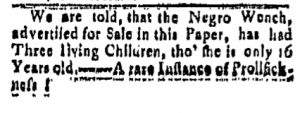Who was the subject of an advertisement in a colonial American newspaper 250 years ago today?

The name Sukey Hamilton, belonging to an enslaved woman of some repute, appeared among the advertisements in the November 24, 1768, editions of both Purdie and Dixon’s Virginia Gazette and William Rind’s Virginia Gazette. Despite variations in typography, identical copy appeared in the notices: “SUKEY HAMILTON, cook to the late Governor, with her youngest daughter, 7 years old, will be sold before Mr. Hay’s door on Thursday the 15th December next. Credit will be allowed for six months, bond and proper security being given.” Francis Fauquier, the lieutenant governor of the Virginia colony who had served as acting governor in the absence of the Earl of Loudon and Jeffrey Amherst for the past decade, had died at the beginning of March. Nine months later, representatives of his estate advertised the sale of his enslaved cook and one of her daughters to take place three weeks later.
Hamilton would bring her own qualifications to any household that purchased her. Prospective buyers likely recognized some cachet in acquiring the cook who formerly served the governor. Yet the notice offered more than just the skill and expertise that Hamilton would contribute to the kitchen. She was to be sold “with her youngest daughter. In Bound to the Fire: How Virginia’s Enslaved Cooks Helped Invent American Cuisine, Kelley Fanto Deetz that enslaved children were “valued with the cook” because they “helped in the kitchen and contributed to the production of meals.” Hamilton’s unnamed seven-year-old daughter likely performed tedious tasks, including picking stems and shucking corn. Over time, Hamilton likely taught her daughter to cook in an attempt to pass down her knowledge to the next generation. According to Deetz, the “practice of having their children working and living next to [enslaved cooks] … carried into the profits of slavery.”
Advertisements for enslaved men often touted their abilities as artisans or skilled laborers. In the same issue of Purdie and Dixon’s Virginia Gazette, for instance, another advertisement listed “two Negro men …, both of whom have been accustomed to attend a mill, and one of them is an extraordinary good cooper.” Many enslaved women, however, also possessed skills and expertise, even when their duties did not place them beyond the household. Their own abilities should not be overlooked merely because they undertook tasks traditionally considered women’s work. Preparing meals in an eighteenth-century kitchen, Deetz declares, “required skill, strength, and perseverance.”[1]
**********
[1] Kelley Fanto Deetz, Bound to the Fire: How Virginia’s Enslaved Cooks Helped Invent American Cuisine (Lexington: University Press of Kentucky, 2017).


